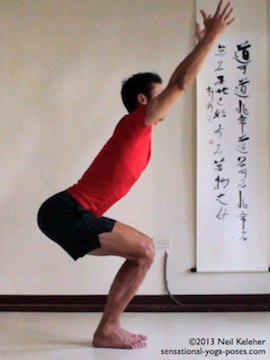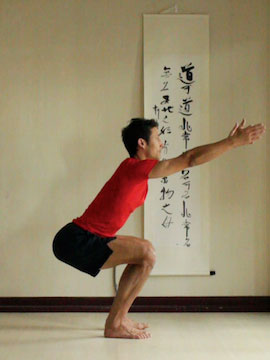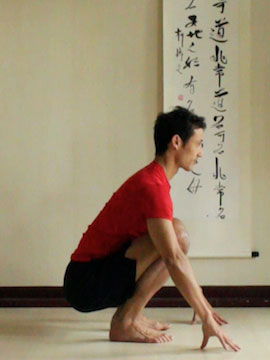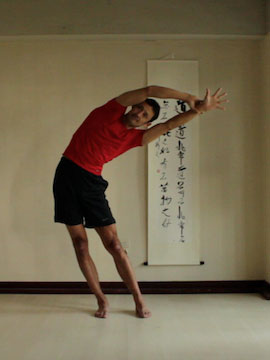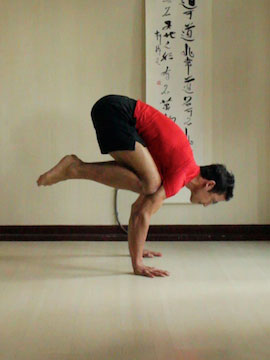Spread Your Shoulder Blades
To make lifting your arms easier, reach your shoulders forwards first. This activates the serratus anterior muscle. Then reach your arms forwards and up while keeping your shoulder blades spread. Start of with your hands shoulder width and try squeezing them towards each other each time you inhale. If you can get them together easily then keep them together.
While trying to bring your arms together focus on reaching them upwards. To make this easier, reach your shoulders upwards while keeping your shoulder blades spread. This action uses the trapezius muscle.
Protect Your Knees
So that it is easier to feel your knees practice moving in and out of chair yoga pose slowly and smoothly. An advantage of moving slowly is that you can stop easily if you do notice pain. You can then make adjustments to the way that you do the pose.
To protect your knees in chair pose the most important thing you can do is focus on feeling your knees. If you focus on feeling your knees you can change the way that you do chair pose if you notice sharp pain or discomfort in your knee joints.
One of the simplest things that you can do to protect your knees is to keep them pointing in the same direction as your toes. To do this you have to be aware both of your feet and your knees.
You can fine tune this relationship by pointing your knees either at your second toe or third toe.
Knee Pain?
I used to do and teach chair yoga pose by reaching the hips back so that both the hips and knees move backwards. The idea of this was to prevent the knees from going to far forwards. However I later found that on occasion when I had knee pain the solution was to move my hips and knees forwards.
This is why it is important that you focus on feeling your knees (and the rest of your body.) If you feel pain you can make adjustments to make your knees alleviate the pain now.
In the section below I talk about adjusting the position of the spine. This too can have an affect on knee pain. To adjust the "shape" of your spine try curving it backwards or forwards or try straightening it. You may find that this sometimes helps.
Anatomy and Alignment in Yoga Chair Pose
Getting into more detailed solutions, one that I am currently working with is activating the sides of the thighs and hips. The muscles activated can include the vastus lateralis (side of the thighs), gluteus minimus, gluteus medius and tensor fascae latae (side of the hips).
To activate these muscles focus on creating a squeezing sensation at the side of the thighs and hips. Then try to vary and move the squeezing sensation, noticing any affects on your knees.
While doing this action, keep your knees pointing in the same direction as your toes. Your inner thigh muscles (adductors) will then more than likely automatically activate to counter act the action of your outer thigh and hip muscles activating.
You can also experiment with moving or expanding the "squeezing" sensation to include the back of the thighs. For myself I find that I can create a "squeeze" just above the backs of the knees. However this may depend on the amount of knee bend that you have.
That may also be another solution to knee pain, change the amount of bend in your knee. The ideal is to have a complete range of motion in your knees, however if you have pain, then slowly work at extending your range of motion. Stay the pain-free side of your range of motion and see if you can slowly work at expanding your range of motion.
One final point is to be aware of your feet. Activate them when doing chair yoga pose. Press down through the root of the big toe, the point at the front of the foot just before the big toe. Lift the center of your inner arch also. (Though this may already be lifted if your knees are pointing in the same direction as your toes.) You can also try pressing down through the front of the foot just behind the little toe.
If you are activating the sides of your thighs you may find that when you also activate your feet your feet feel very strong and stable.
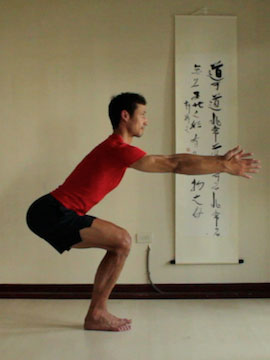 In this picture, I'm reaching my arms forwards to help balance while I push my hips (and knees) back.
In this picture, I'm reaching my arms forwards to help balance while I push my hips (and knees) back. Bending Your Spine or Straightening It
Three options for your spine include straightening it, bending it backwards or bending it forwards.
Bending it backwards you can engage your spinal erectors. However if you tilt your pelvis backwards a little you and focus on straightening your lumbar spine (make your lower back "feel full") you may get a feeling of "openness" in the lower back/kidney area that feels really nice.
If you are going to use your spinal erectors to bend your spine backwards, see if you can also use them to "flick" your tailbone backwards. You may feel a "pull" at the back of your sacrum as you do this.
After pulling your tailbone back you can then activate your pubococygeus and try pulling it forwards towards your pubic bone while keeping your spinal erectors active. While doing this you may feel some of your deeper hip muscles activating (maybe piriformins, obturator internus, gemellus superior and inferior and quadratus femoris.)
Lifting your ribs
One of the challenges of chair yoga pose is to lift up even though you are sinking down. Focus on lifting your ribs and arms (and head) away from your pelvis.
You can practice moving your ribs away from your pelvis while standing. Work at keeping the same feeling as you bend your knees and sink your hips down. Reach your ribs and arms away from your pelvis as you sink your pelvis down.
You can turn this into a breathing vinyasa by lengthening your upper body as you inhale and relaxing while you exhale. Focus on moving your ribs, shoulders and arms up while you inhale and then on relaxing slightly while you exhale. You can also focus on lengthening your neck and on opening the top of your chest while you inhale.
Activating Your Legs
For extra stability and to build up leg strength while doing chair yoga pose, pull your knees back towards your pelvis and push your sitting bones forwards at the same time. The feeling is that of trying to squash your thigh bones.
You'll feel your quads (front of the thighs) and gluteus maximus (back of the thighs) activating at the same time. See if you can gradually increase the squeeze and gradually reduce it in time with your breath.
Strengthening Your Legs Through a Full Range of Motion
So that you can strengthen your legs more completely you can use chair pose as an excuse to practice squatting.
Slowly lower into chair pose. Pause for a few breaths and then slowly stand back up. Repeat a few times.
Next, lower down to chair pose, hold, and then instead of going up, slowly lower down to a full squat. Turn your feet out if you need to so that you can keep your heels down. You can spread your knees and reach your ribcage forwards to help you balance.
Rest while in this squat, and then slowly raise up to utkatasana again. Pause and then lower back down to a squat.
You can finish off by lifting up into chair pose, pause, and then from there slowly (about 5 to 10 seconds) stand up.
Reasons for Doing a Full Squat
Why practice squatting? A kung fu teacher told me that he sleeps on the floor because each night he has to squat to get to bed. His rational, is that if you don't use it you lose it, i.e. the ability to squat.
By practicing squatting, or by using chair pose as an opportunity to squat you can help to recover or retain the full range of motion of your knees and hips.
If you can't go all the way down then work towards it slowly. Gradually work at making your chair pose lower. Use blocks, books or a rolled up mat under your heals if your need to.
Note in the middle picture, by spine is slightly bent forwards. In the "relaxed" squat I think this is okay. However, while lowering down or raising upwards, do work at keeping your spine bent backwards. Also when relaxing, or when reengaging to get back up, do both actions smoothly.
Another reason for doing squats is that it will make your legs and butt stronger.
And yet another, you may find that it makes doing Chair Pose easier.
Resting After Chair Yoga Pose
After doing chair pose you can give your thighs a rest by doing a standing side bend. Focus on contracting the muscles along the side of your body. If bending to the right, contract the muscles on the right side of your body. Meanwhile focus on opening and lengthening the other side of your body.
Another alternative is to do crow pose (bakasana).
If while doing chair pose you focused on using your spinal erectors to bend your spine backwards, in bakasana you can focus on using your abdominals to bend your spine forwards. Also use your abdominals to help pull your knees into your arms.
Published: 2011 01 29
